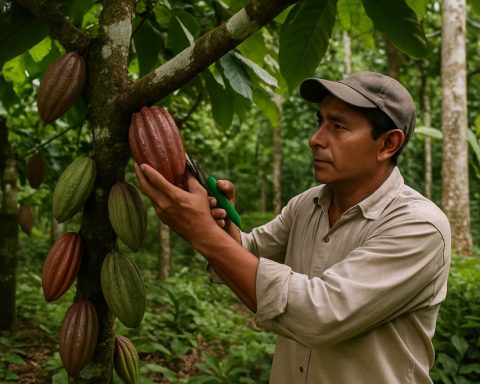- The RFK Stadium in Washington, D.C., is poised for a major transformation that aims to renew community vitality and urban planning.
- The redevelopment plan includes converting the stadium grounds into green spaces, community centers, and possibly residential areas, invigorating the local economy.
- A key aspect of the project involves relocating aircraft near the stadium to streamline airspace and support urban evolution.
- This relocation prioritizes noise reduction and improves living conditions for residents, showcasing thoughtful urban planning.
- The project balances historical preservation with innovation, blending past stories with future opportunities for the city.
- Overall, the initiative highlights strategic foresight, proving that harmonious city growth is achievable.
Beneath the vast skies of the nation’s capital, a quiet revolution brews. The aging RFK Stadium, an iconic vestige of Washington’s storied past, stands at the threshold of transformation. This metamorphosis is not merely a facelift but a bold reimagining that could ripple through the city’s aviation sector like a descending jet stream.
Over the years, RFK Stadium has played host to everything from heart-stopping football clashes to raucous concerts echoing across its coliseum of concrete. Yet, its grip on relevance loosened as teams migrated to newer venues, leaving this titan of architecture to linger in limbo. Now, a multifaceted redevelopment plan stretches its wings over the horizon, promising new life not only for the stadium but also for the surrounding community.
A key piece of this ambitious puzzle lies in the relocation of aircraft based near the stadium, a move intended to declutter airspace and streamline future urban planning. It’s a meticulous choreography involving myriad stakeholders—from aviation experts to urban developers—all bound by the vision of a revitalized cityscape.
But why does this matter to the average Washingtonian or, for that matter, to anyone interested in urban development? Simply put: progress demands space. The RFK Stadium redevelopment, coupled with strategic aviation adjustments, showcases a model of urban evolution that prioritizes both historical preservation and forward momentum. It’s a dance of innovation and nostalgia, ensuring the vibrancy of yesterday’s stories mesh seamlessly with tomorrow’s opportunities.
Initiatives to transform the stadium’s expansive grounds into vibrant community spaces are not merely sketches on a planner’s desk. Plans include green spaces, community centers, and potentially even residential areas which can invigorate the local economy while offering a breath of fresh air—literally and metaphorically—to Washington’s urban landscape.
The aircraft relocation initiative may seem managerial, even mundane at first glance. However, its ramifications echo far beyond the physical movement of metal and machinery. By reallocating air traffic paths and reducing noise pollution, the decision prioritizes the well-being and peace necessary for a thriving residential community.
Ultimately, the RFK Stadium transformation epitomizes strategic foresight in urban planning. It’s a bold assertion that progress and heritage can coexist—a testament to human ingenuity in the face of evolving cityscapes. As planes chart new courses across the District’s skies, the city below prepares to take flight in its own right, proving once again that even the most ethereal dreams can find grounding in reality.
RFK Stadium’s Transformation: A New Beginning for Urban Development and Aviation Harmony
The revitalization of RFK Stadium reflects a transformative vision that merges heritage and innovation, casting its influence over both urban development and aviation. Delving deeper into this transition, we unearth further implications and prospects at play beneath the surface of the redevelopment initiative.
Why RFK Stadium’s Transformation Matters
The redevelopment of RFK Stadium marks a significant shift in urban sustainability and planning. As the stadium evolves, so does the potential for increased community value, driven by a fusion of modern innovation and respect for historical legacy.
– Economic Revitalization: Transformation into a mixed-use space can potentially inject millions into the local economy, fostering job creation and community engagement. According to urban studies, such developments typically see a boost in local business viability and real estate appreciation.
– Community Spaces and Green Initiatives: The envisioned transformation would include parks, community centers, and sustainable infrastructure, reflecting a commitment to environmental well-being and social inclusivity—principles central to current urban planning philosophies, such as those discussed by the American Planning Association (American Planning Association).
Insights into the Aviation Sector’s Role
The relocation of aircraft near RFK Stadium forms a critical component of this urban renaissance, reducing air traffic congestion and improving quality of life for local residents.
– Noise Reduction and Air Quality: Redirecting flight paths can significantly decrease noise pollution, as supported by studies from the Environmental Protection Agency (EPA). This positively impacts mental health and property values in neighboring communities.
– Future-Proof Planning: Aligning with urban evolution demands, the adaptation in air traffic management showcases foresight in mitigating congestion and preparing for increased air travel demand. This approach aligns with future urban mobility concepts emphasized by the FAA (Federal Aviation Administration).
Pros and Cons of the Redevelopment Project
Pros:
– Improved Urban Infrastructure: Enhanced connectivity and modern amenities benefiting economic growth and community welfare.
– Environmental Benefits: Incorporation of green spaces and sustainable practices reducing urban heat and promoting biodiversity.
– Cultural and Social Impact: A platform for cultural events, sports, and social gatherings that reinforce community bonds.
Cons:
– Initial Disruptions: Construction phases may disrupt local traffic and daily activities, though these are typically temporary inconveniences.
– Financial Risks: Large-scale projects often face budgeting challenges that require careful fiscal strategy and public-private partnerships.
– Heritage Concerns: Balancing historical preservation with modern needs, a challenge acknowledged by projects like New York’s High Line redevelopment.
Actionable Recommendations
1. Community Involvement: Engage local residents in planning processes to ensure developments meet the actual needs and expectations of stakeholders.
2. Sustainability Focus: Prioritize eco-friendly materials and practices and incentivize green buildings within the redevelopment area.
3. Monitor and Adapt: Establish metrics for assessing project impact and adaptability to adjust as necessary, safeguarding long-term success.
4. Leverage Technology: Use smart infrastructure solutions to optimize resources and enhance safety, from traffic management to energy efficiency.
In conclusion, RFK Stadium’s transformation could serve as a blueprint for urban redevelopment projects across the globe, harmonizing environmental priorities with socio-economic progress. By forging a path that respects and revives, Washington D.C. challenges other cities to envision the possibilities of such balanced urban innovation. For more on smart urban planning, visit the SmartCitiesWorld.







